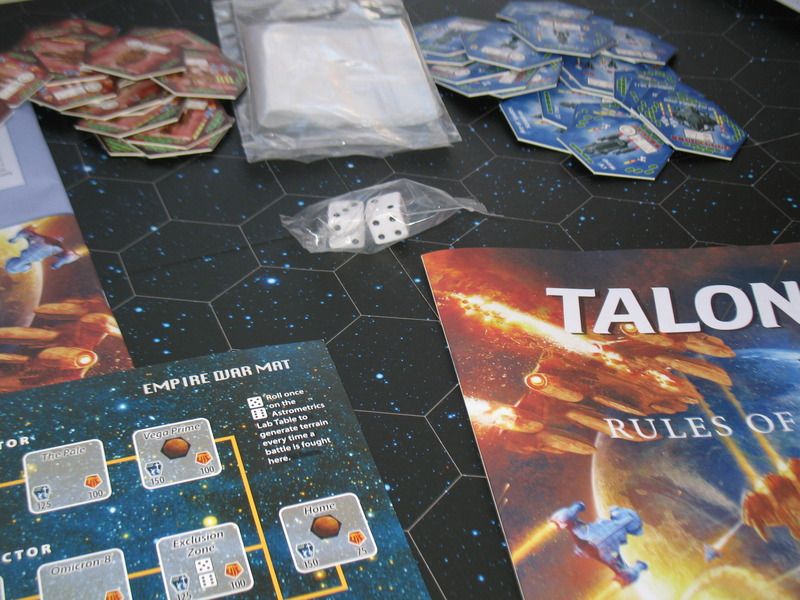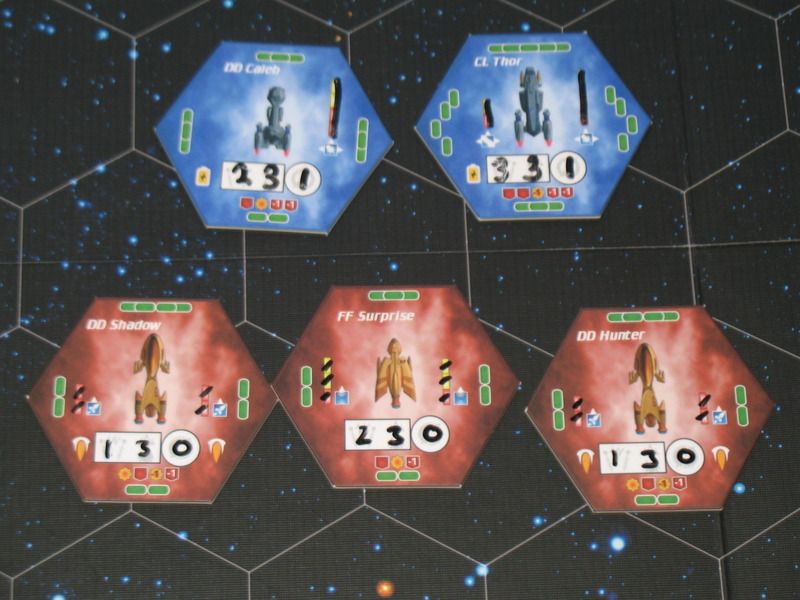
I’ve been looking forward to this game for some time and I’m not the only one; the guy at GMT games table at PrezCon was surprised the week before last when the six copies they’d brought sold out in fifteen minutes. You don’t normally see the “fighty” space games on the table there, but people were playing this one. And though I missed getting a copy to take home with me, I nevertheless got to play it with a table full of people eager to learn. Several people walking had questions about this game, so I’ll go ahead and give a few preliminary observations just so people can know what this is.
The box is just plain loaded. The best part is the piles large ship counters. They’re gorgeous. Also, the rules are delightfully short and the scenario book is very, very fat. So far so good! People cracking open the shrink-wrap on this one are immediately faced with a dilemma, however. Should they use the dry erase pens to write power, speed, and turn mode figures directly on the counters themselves or should they use the paper record sheets that are provided? Well, I’m not the most OCD boardgamer I know and it still pained me to write on these things. But the elimination of ship cards and Xerox copies really is worth it, though– everything you need to know about a situation can be read directly from the board. Yeah, the counters will get smudged up in the process, but writing on them is the way to go.
 The big surprise for me with this game was that power is generated on a similar impulse schedule as movement points. It’s just not the design choice I was expecting because for a “quick moving fleet game” it sure seems to slow things down. Whereas in Federation Commander, movement tends to go quickly and things only bog down with there’s lots of weapons fire and damage allocation, Talon seems to slow down a little every time someone gets a new energy point to spend. It’s just not obvious what to with them. Novices have lots of questions about them. And it takes time to double check with everyone on whether or not the even get power in the current impulse. This is the crux of the game, though– the second big innovation that the game is built on. Going by the designer’s notes, Jim Krohn is pretty proud of this approach to power allocation, so I’m just going to trust him on this one for now.
The big surprise for me with this game was that power is generated on a similar impulse schedule as movement points. It’s just not the design choice I was expecting because for a “quick moving fleet game” it sure seems to slow things down. Whereas in Federation Commander, movement tends to go quickly and things only bog down with there’s lots of weapons fire and damage allocation, Talon seems to slow down a little every time someone gets a new energy point to spend. It’s just not obvious what to with them. Novices have lots of questions about them. And it takes time to double check with everyone on whether or not the even get power in the current impulse. This is the crux of the game, though– the second big innovation that the game is built on. Going by the designer’s notes, Jim Krohn is pretty proud of this approach to power allocation, so I’m just going to trust him on this one for now.
The other big shocker with the game is that movement did not at all work like I expected. Sideslips are not free, for instance. They have to be bought with a power point and if you don’t use it on your next move, it’s lost altogether. There is no hard and fast “fast ships move after slow ships” rule– and no “seeking weapons move after ships”, either. Initiative is by side and it can even change hands from impulse to impulse. Furthermore, one of the things you can do with your power points here is use them to pay down your turn mode. Those battle-pig Terran ships? They’re far more maneuverable than they look!
 So yes, this is very much a game. If you were looking for a dog-fighting simulation, this will disappoint you. (One guy at PrezCon decided to house rule it after the first session so that real fighter pilot tactics would actually work with it.) I doubt very many people will care about that, though. This is the sort of game people have been waiting for for a long time. It will be very easy to get play out of it and I doubt finding opponents for this one will be that much of a chore. (The low complexity combined with the top notch production values are just a huge help there.)
So yes, this is very much a game. If you were looking for a dog-fighting simulation, this will disappoint you. (One guy at PrezCon decided to house rule it after the first session so that real fighter pilot tactics would actually work with it.) I doubt very many people will care about that, though. This is the sort of game people have been waiting for for a long time. It will be very easy to get play out of it and I doubt finding opponents for this one will be that much of a chore. (The low complexity combined with the top notch production values are just a huge help there.)
Talon of course mates up with Space Empires: 4X to make the ultimate in monster space games, but with twelve scenarios and a separate Empire War campaign game, there’s plenty else to do here without getting crazy. I actually don’t know how well I like it myself, yet. There’s so many things about this that are just plain different from all the space games on my shelf, I just don’t know what to think yet. Finally having something about midway between the complexity levels of Ogre/G.E.V. and Federation Commander is very nice, though. This is a game that definitely deserves a look.
Makes me glad it should be coming my way soon. I need a ship combat fix, it doesn’t have to be a dogfight, but a good game.
I P500ed this, but it’s still sitting on my shelf waiting for me to get it on the table. I’m looking forward to it, though. (It was your recommendation on this very blog that first got me into Space Empires 4X.)
Played it once so far. Good game, and I like the price, but I’m not sure it really does anything FedCom doesn’t, and, as a fan of Attack Vector, I thought the author’s casual dismissal of the possibilities of 3-d were a little off.
Speaking of dogfighting tactics…Talon’s principle combatants are naval ships of various sizes, but similar maneuvering principles do apply albeit at relatively slower speeds and with less agility. Talon’s power curves are quite innovative making power management, speed and turn-radius calculations, based on ship size, race design and speed, quick and easy for players. Talon’s movement system appears to be quite simplified, as Jeffro noted. Simplified movement does make Talon easily approachable for players, but sacrifices maneuverability beyond simple turns, and adds disproportionate turning and sideslips for larger ships which simply have more available energy neglecting the higher mass and larger size. Whereas a smaller vessels due to limited energy even at modest speeds, can be outmaneuvered by larger vessels using excess energy to shorten their turn radius and sideslip. Also, I do realize that Talon’s initiative system is an amalgam of things such as possibly electronic counter measures, command control, etc. However, slow moving ships or even stationary ships of one race gaining the initiative simply, because they spend more energy than fast maneuvering opposing ships which spent less energy or lack enough energy to compete for the initiate does not compute. None of these makes sense. Talon’s fighters look interesting too, but the carriers and bases beaming energy to power the fighters seems rather peculiar, unlike common science fiction space fighters. As Jeffry noted, some of Talon’s limitations could be remedied with a few simulation-oriented house rules.